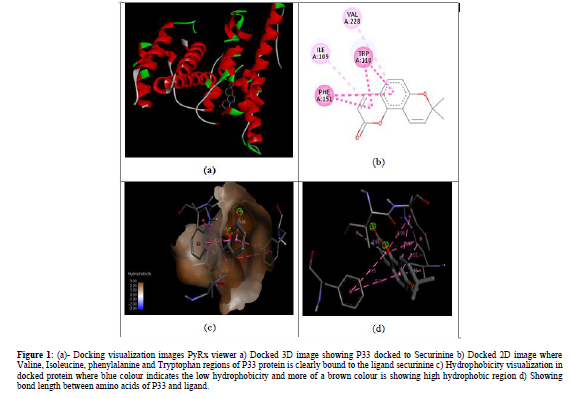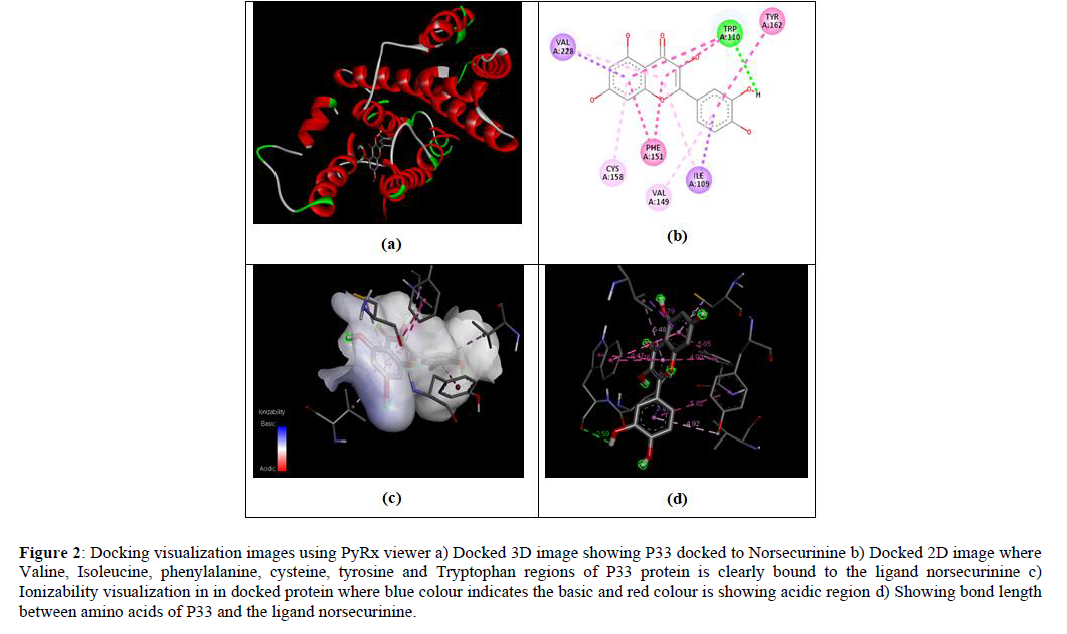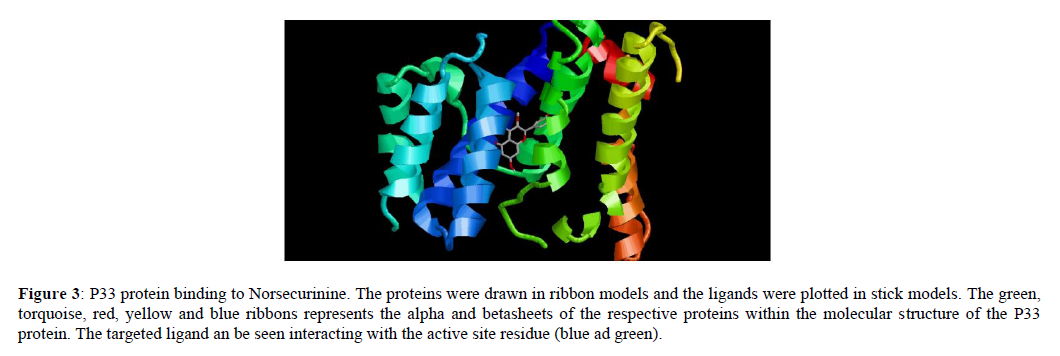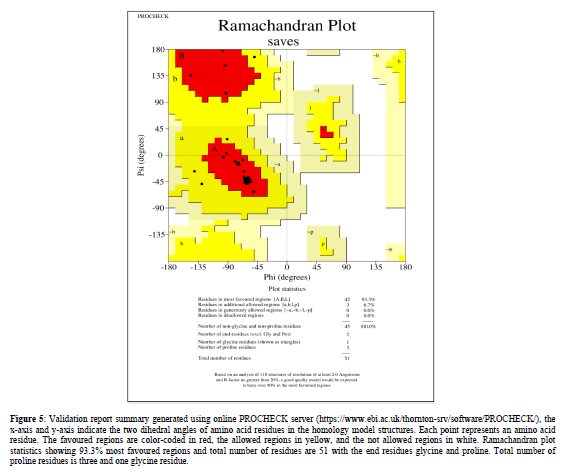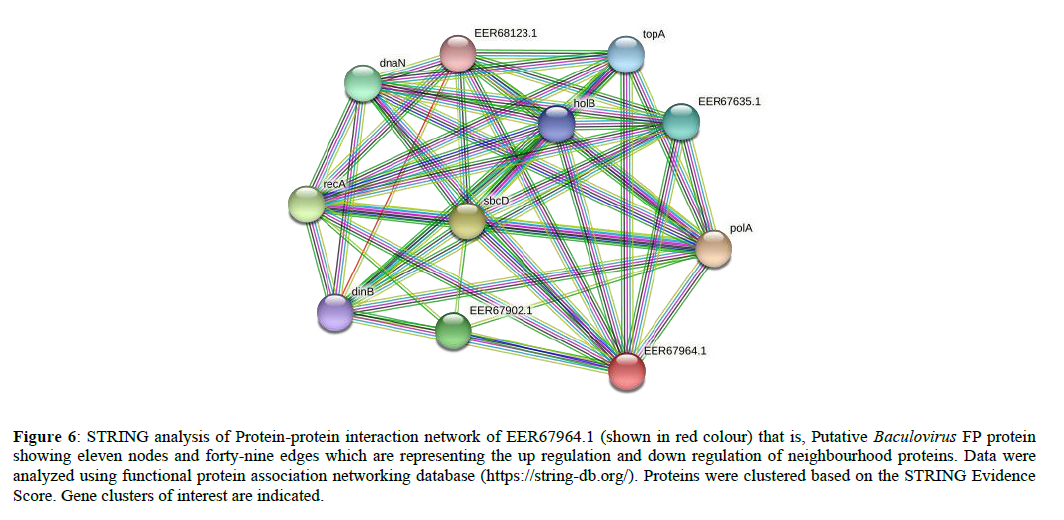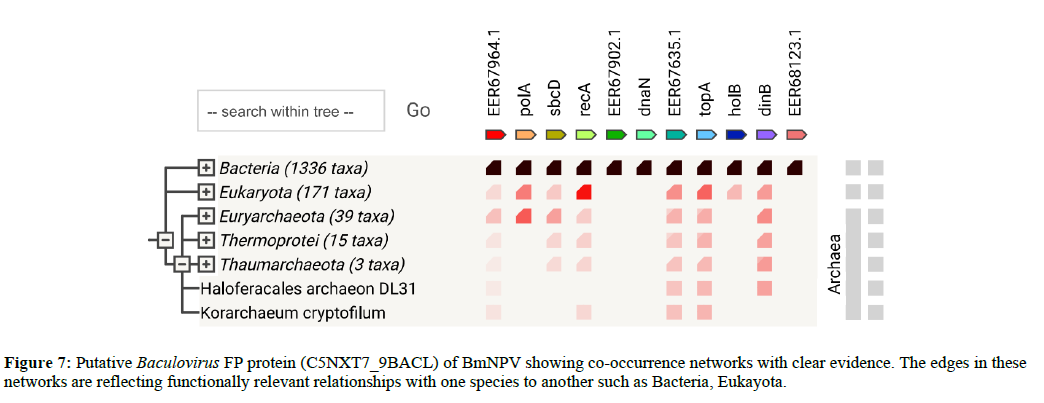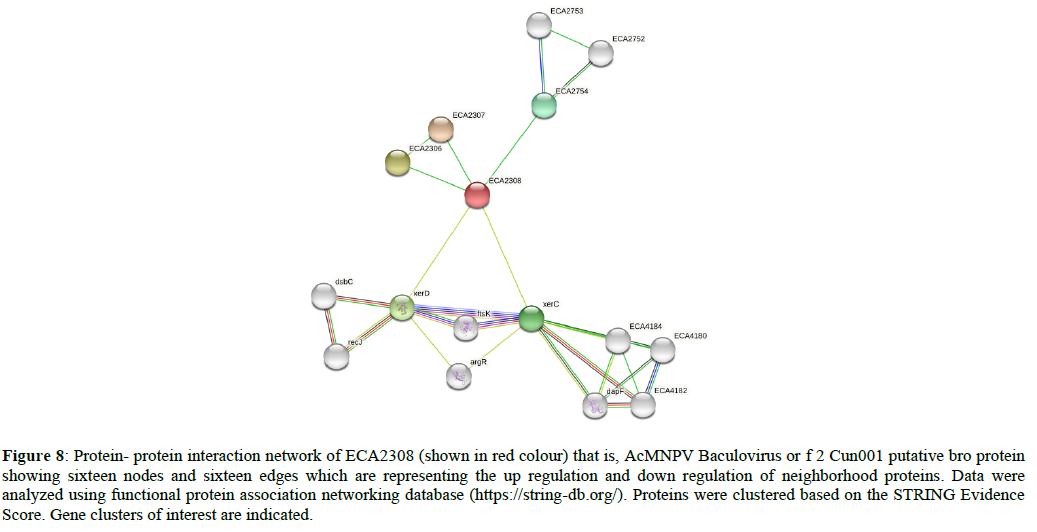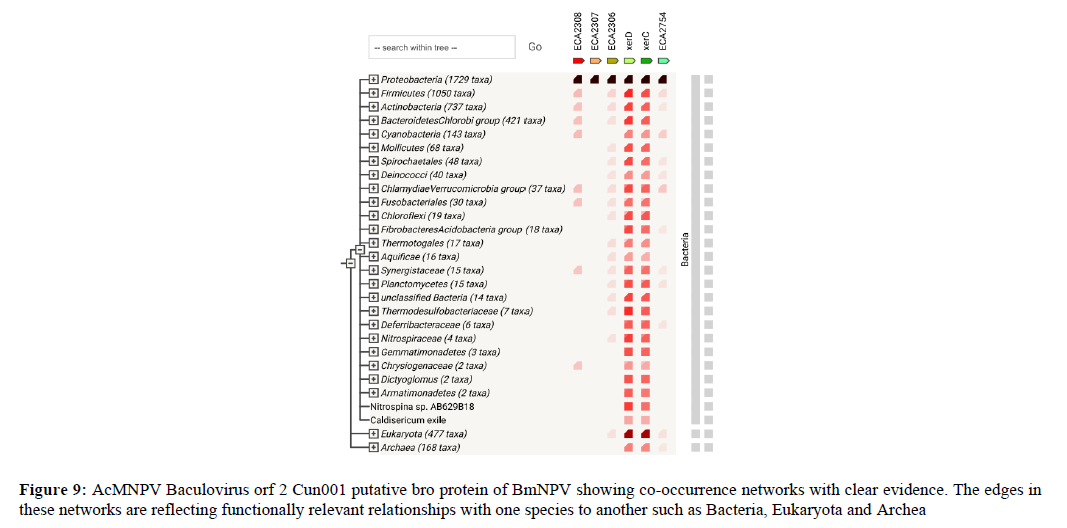Research Article - Der Pharma Chemica ( 2023) Volume 15, Issue 2
A network Pharmacology-Based prediction and verification of the major protein targets of BmNPV obtained from modern sequencing technology against plant active ingredients
Madhuri Sathyanarayana, Avinash Basavarajappa, Kotresh K Rajashekarappa and Neelagund SE*Neelagund SE, Department of Biochemistry, Kuvempu University, Shankaraghatta, India, Email: neelgund@gmail.com
Received: 04-Feb-2023, Manuscript No. dpc-23-89086; Editor assigned: 06-Feb-2023, Pre QC No. dpc-23-89086; Reviewed: 20-Mar-2023, QC No. dpc-23-89086; Revised: 21-Mar-2023, Manuscript No. dpc-23-89086; Published: 28-Mar-2023, DOI: 10.4172/0975-413X.15.2.11-20
Abstract
Baculoviruses encode a conserved sulfhydryl oxidase, Ac92, P33 proteins. Its role during viral replication is unknown but Ac92 has homology to
the family of flavin adenine dinucleotide-linked sulfhydryl oxidases. It is related to the ERV/ALR family of sulfhydryl oxidases, which is necessary
for budded virus (BV) production and multinucleocapsid occlusion-derived virus (ODV) formation. Here, we attempted to supress the protein P33
using molecular docking. The active ingredients of Phyllanthus amarus was used as ligands. Resulted in the successful docking result with high
binding affinity of -10.0 and -9.1 Kcal/Mol for Norsecurinine and Securinine. Along with this, we also deduce the Protein-protein interaction
network using two major proteins such as Putative Baculovirus FP protein and AcMNPV Baculovirus orf 2 Cun001 putative bro proteins. The
networks are clearly showing the function of BmNPV gene depending on other functional proteins.
Keywords
BmNPV; Grasserie infection; Molecular Docking; Protein-protein interactions; P33
INTRODUCTION
Since ancient times, Bombyx mori has been intensively investigated for its economic and academic worth. The production of silk is the silkworm's most valuable economic asset [1 ]. Unfortunately, the silkworm larvae are susceptible to a variety of infectious illnesses caused by bacteria, viruses, fungi, and protozoans, which has resulted in significant cocoon yield reduction in the sericulture industry (Su, 1990). Flacherie (bacterial), muscadine (fungal), grasserie (viral), and pebrine (parasitic) are the most prevalent infectious diseases of silkworms [2-4]. Grasserie is one of the most serious diseases produced by a Baculovirus called B. mori nuclear polyhedrosis virus (BmNPV) [5]. The occurrence and advancement of disease can be seen during the fourth and fifth instar larval development stages, which lead to mass death and the loss of money, time, and labour. Various disinfectants are used in a variety of preventative and curative treatments to manage this condition. In India, the Central Sericultural Research and Training Institute (CSR & TI), Mysore developed "Resham Keet Oushad" to combat the disease. Datta et al., (1998) created "Vijetha" to combat all silkworm illnesses. "Sanjeevini" was developed by Patil and Sharadama (1999) to combat grasserie and flacherie. Chemicals and bed disinfectants are efficient, but they have a long-term effect and are therefore not regarded eco-friendly or cost-effective.
The one-drug/one-target/one-disease approach to drug development is currently confronting numerous problems in terms of safety, efficacy, and long-term viability. Recent trends in genomics data integration and the development of multitarget medications have given rise to network biology and polypharmacology methods, respectively. Network pharmacology (NP), which investigates pharmacological effects on both the interactome and the diseasome level, is a new paradigm that was created by combining these two methods. As a result, using bio formulations derived from plants is the ideal option because they are non-toxic, biodegradable, and easy to manufacture and adopt by farmers. Furthermore, they can be used in the sericulture business at any time of year to promote the health of cocoon and silk output [6,7]. Many of these botanicals have been tried against BmNPV and have shown to be effective.
The Indian medicinal plant Aegle marmelos L., also known as bael, is a member of the Rutaceae family and is utilised extensively in many different indigenous Indian medical systems. It has tremendous traditional value in the treatment of many different ailments. A. marmelo’s leaf, fruit, bark, and roots have all produced a variety of bioactive compounds that have been isolated, and their extracts have been used in traditional medicine to benefit from their therapeutic properties, which include anti-diabetic, anti-ulcer, anti-oxidant, anti-malarial, anti-inflammatory, anti-cancer, radio protective, anti-hyperlipidemic, anti-fungal, anti-bacterial, and anti-viral actions [8,9].
Phyllanthus is an exceptionally valuable genus in traditional medicine since it is utilised in folk medicines in many different nations throughout the world. There is a long history of using the Phyllanthus genus to treat diabetes, intestinal parasites, issues with the liver, kidneys, and bladder. Some related species in this region with medicinal significance are P. niruri, P. epiphyllanthus, P. urinaria, P. emblica, P. acuminatus, P. amarus and P. urinaria are used in the treatment for kidney/gallstones, other kidney related problems, appendix inflammation, and prostate problems [10,11].
To identify the antiviral drug obtained from plants against BmNPV infection in silkworms using in silico methodologies. Identification and collection active ingredients by available literature. Recognition of major gene products of BmNPV, responsible for grasserie infection in silkworms. In silico antiviral activity of selected ligands against BmNPV.
MATERIALS AND METHODS
Ligand preparation for molecular docking
The structures of the ‘ligands’ i.e., the anti-BmNPV compound seselin (ligand-1), Gallocatechin (ligand-2), Isobubbialine (ligand-3), Norsecurinine (ligand-4), Rutin (ligand-5), Securinine (ligand-6) Epibunnialine (ligand-7), Quercetin (ligand-8) were downloaded from PubChem (https://pubchem.ncbi.nlm.nih.gov/) and the geometry optimizations and energy minimization of the ligands were performed by the help of MarvinSketch tool [12].
Analyzing Drug like nature
The online drug design software by Supercomputing Facility for Bioinformatics & Computational Biology (SCFBio), IIT Delhi (http://www.scfbio-iitd.res.in/software/drugdesign/lipinski.jsp) and SwissADME tool (http://www.swissadme.ch/) allows you to compute physicochemical descriptors as well as to predict ADME parameters, druglike nature, pharmacokinetic properties and medicinal chemistry friendliness of one or multiple small molecules to support drug discovery. This tool listed out the parameters like Molecular mass, Lipophilicity, Hydrogen bond acceptor and donor count, Molar refractivity which aided to analyse whether seselin, satisfies Lipinski’s rule of 5. In addition, the SWISS ADME tool gives the Bioavailability percentage, GI tract and Blood Brain Barrier absorption percentage [13].
Template identification and structure modeling
The major protein P33 is reported to be essential for oral infectivity of NPV occlusion-derived virus (ODV) in the larvae of silkworm, B. mori. Subsequently the obtained targets were imported in Uniprot database (https://www.uniprot.org/) to acquire its Gene name, Gene ID and Function. P33 protien 3D structure of protein was obtained from the Protein Data Bank (PDB) (http://www.rcsb.org/). Using discover studio, we have to prepare the protein by deleting water molecule, hetatom and ligands. Hydrogen molecules should be added in the end and saved file as pdb format [14].
Molecular Docking
A key tool in network pharmacology is molecular docking, which connects known proteins with small compounds. Molecular docking was performed using the Pyrx software to validate compound-target interaction [15,16]. Prepared ligand and proteins were imported to pyrx tool to perform docking and the docked model structures were visualized by Discovery studioDiscovery Studio (https://www.3ds.com/products-services/biovia/) and Rasmol.
Model validation
Modelling servers such as PDBsum and SWISSModel (Kelley et al., 2015) are used to validate the protein stucture. Further quality of models was assessed using PROCHECK [ 17]. The best model was selected based on the Ramachandran Plot obtained from PDBsum. This server predicts regions of secondary structure from the protein sequence such as alpha helix, beta sheet, and turns from the amino acid sequence [18].
Protein – Protein Interaction (PPI) Analysis
A very big database of functional association information is analyzed by STRING (https://string-db.org) to identify additional proteins that are connected to a set of input proteins. Protein and genetic relationships, pathways, co-expression, co-localization, and protein domain similarity are all examples of association data. In this study we used this STRING: functional protein association networks database to construct PPI interaction of Baculovirus gene. The results help us to predict the infective genes of the virus have high interaction with other gene sets [19].
RESULTS AND DISCUSSION
Analysing Drug like nature of the ligands
Drug-likeness prediction of seselin (ligand-1), Gallocatechin (ligand-2), Isobubbialine (ligand-3), Norsecurinine (ligand-4), Rutin (ligand-5), Securinine (ligand-6) were in line with Lipinski’s RO5, indicating that it has good drug like properties. Where Epibunnialine and Quercetin were not satisfying the rule. It shows that Bioavailability and GI absorption of 6 ligands were also high. Where, Chitra Somu et al., 2019 suggested functionally and structurally characterized molecule of seselin was considered as anti-BmNPV compound [20-22].
Lipinski Rule of Five
Lipinski rule of five helped in distinguishing between drug like and non-drug like molecules. There are five rules such as molecular mass should be less than 500 Dalton, ligand should have high lipophilicity (LogP less than 5), ligand should contain less than 5 hydrogen bond donors, drug molecule should contain 10 hydrogen bond acceptors and molar refractivity should be in between 40-130 (Table 1).
| Sl. No | Ligands | Molecular mass | Hydrogen bond donors | Hydrogen bond acceptor | High lipophilicity (LOGP) | Molar refractivity |
|---|---|---|---|---|---|---|
| 1 | Epibubbialine | 306 | 6 | 7 | 1.2517 | 74.287773 |
| 2 | Gallocatechin | 221 | 1 | 4 | 0.2097 | 55.662792 |
| 3 | Isobubbialine | 203 | 0 | 3 | 1.0149 | 54.178989 |
| 4 | Norsecurinine | 302 | 5 | 7 | 2.0109 | 74.050476 |
| 5 | Quercetin | 610 | 10 | 16 | -1.8788 | 137.495483 |
| 6 | Rutin | 217 | 0 | 3 | 1.405 | 58.79599 |
| 7 | Securinine | 228 | 0 | 0 | 2.802999 | 64.85199 |
| 8 | Seselin | 228 | 0 | 0 | 2.802999 | 64.85199 |
| Where, Epibubbialine and Quercetin are having more than 5 hydrogen donor. Quercetin having high Molecular mass and also high Molar refractivity. All other ligands are satisfying the rules with accurate parameters. *The ligands which are not following the rules of Lipinski are marked in red | ||||||
Molecular Docking Results and Analysis
Total of 6 plant active chemicals were selected out of 8 based on their role in suppressing grasserie from previous study and performed Docking with P33 protein from NPV virus. The Binding energies of the respective ligands with the protein were obtained. From the results, it was evident that Norsecurinine and Securinine had good affinity for P33 with the value -10.0 and -9.1 Kcal/Mol. Fernand et al., 2003 successfully did the initial characterization of crude extracts from Phyllanthus amarus using normal phase thin layer chromatography where the major phytochemical is Norsecurinine and Securinine. Which showed better efficiency when compare to other ligands.
Sulfhydryl oxidase P33, which is encoded by baculoviruses, is essential for the generation of progeny viruses and plays a crucial role in morphogenesis and oral infectivity of baculoviruses. On the hypothesised redox route of Baculoviruses, P33's downstream substrates are unknown. Huanyu Zhang et al., 2020 demonstrated that PIF5, one of the per os infectivity factors (PIFs), included intramolecular disulfide bonds and that the production of these bonds was disrupted in the absence of P33 (Table 2).
| Ligand | Binding Affinity (Kcal/Mol.) |
|---|---|
| p33_prepare_Securinine_lig7_uff_E=141.30 | -9.1 |
| p33_prepare_Securinine_lig7_uff_E=141.30 | -8.8 |
| p33_prepare_Securinine_lig7_uff_E=141.30 | -8.5 |
| p33_prepare_Securinine_lig7_uff_E=141.30 | -8 |
| p33_prepare_Securinine_lig7_uff_E=141.30 | -7.9 |
| p33_prepare_Securinine_lig7_uff_E=141.30 | -7.8 |
| p33_prepare_Securinine_lig7_uff_E=141.30 | -7.8 |
| p33_prepare_Securinine_lig7_uff_E=141.30 | -7.7 |
| p33_prepare_Securinine_lig7_uff_E=141.30 | -7.6 |
| Where, the first model p33_prepare_Securinine_lig7_uff_E=141.30 having high binding affinity of -9.1 Kcal/Mol | |
Visualization of Norsecurinine and Securinine Docked molecule using RasMOL
The docked complex when viewed by RasMOL viewer, showed that the ligand docked very well to the protein sequence. The binding affinity was -9.1 Kcal/mol for the complex formed between securinine and P33, and the binding affinity was -10.0 Kcal/mol for the complex formed between norsecurinine and P33. The analysis compound is recommended as the best therapeutic medication by the Lipinski rule's outcome. The outcomes of docking studies support the use of substances as prospective, all-natural medicinal agents for the treatment of disease.
Figure 1. (a)- Docking visualization images PyRx viewer a) Docked 3D image showing P33 docked to Securinine b) Docked 2D image where Valine, Isoleucine, phenylalanine and Tryptophan regions of P33 protein is clearly bound to the ligand securinine c) Hydrophobicity visualization in docked protein where blue colour indicates the low hydrophobicity and more of a brown colour is showing high hydrophobic region d) Showing bond length between amino acids of P33 and ligand.
| Ligand | Binding Affinity (Kcal/Mol.) |
|---|---|
| p33_prepare_Norsecurinine_lig4_uff_E=379.98 | -10 |
| p33_prepare_Norsecurinine_lig4_uff_E=379.98 | -9.3 |
| p33_prepare_Norsecurinine_lig4_uff_E=379.98 | -8.9 |
| p33_prepare_Norsecurinine_lig4_uff_E=379.98 | -8.6 |
| p33_prepare_Norsecurinine_lig4_uff_E=379.98 | -8.4 |
| p33_prepare_Norsecurinine_lig4_uff_E=379.98 | -8.3 |
| p33_prepare_Norsecurinine_lig4_uff_E=379.98 | -8.2 |
| p33_prepare_Norsecurinine_lig4_uff_E=379.98 | -8.1 |
| p33_prepare_Norsecurinine_lig4_uff_E=379.98 | -8.1 |
| Where, the first model p33_prepare_Norsecurinine_lig4_uff_E=379.98 having high binding affinity of -10 Kcal/Mol | |
Figure 2. Docking visualization images using PyRx viewer a) Docked 3D image showing P33 docked to Norsecurinine b) Docked 2D image where Valine, Isoleucine, phenylalanine, cysteine, tyrosine and Tryptophan regions of P33 protein is clearly bound to the ligand norsecurinine c) Ionizability visualization in in docked protein where blue colour indicates the basic and red colour is showing acidic region d) Showing bond length between amino acids of P33 and the ligand norsecurinine.
| Ligand Name | Pubchem ID | Binding affinity (Kcal/Mol) |
|---|---|---|
| Securinine | 442872 | -9.1 |
| Norsecurinine | 11106439 | -10 |
| Out of six ligands securinine and norsecurinine showed high affinity towards P33 with binding affinity of -9.1 and -10.0 Kcal/Mol | ||
Figure 3. P33 protein binding to Norsecurinine. The proteins were drawn in ribbon models and the ligands were plotted in stick models. The green, torquoise, red, yellow and blue ribbons represents the alpha and betasheets of the respective proteins within the molecular structure of the P33 protein. The targeted ligand an be seen interacting with the active site residue (blue ad green).
Figure 4. P33 protein binding to Securinine. The proteins were drawn in ribbon models and the ligands were plotted in stick models. The green, torquoise, yellow and blue ribbons represents the alpha and betasheets of the respective proteins within the molecular structure of the P33 protein. The targeted ligand an be seen interacting with the active site residue (blue ad torquoise).
Ramachandran plot
The model thus generated was subjected to PROCHECK server for the validation. An assembly of protein structures could have their geometry and constraint breaches verified using PROCHECK algorithms. A thorough explanation of the restraint violations, many charts in PostScript format, and summary data were all included in the outputs. These numerous evaluations demonstrated the quality of the geometrical features of the model structures as well as the degree to which they agreed with the experimental data. The model was submitted to PROCHECK server in PDB format with 3D coordinates. The validation report in the form of Ramachandran Plot was downloaded and represented in (Figure 5). The favored region in the structure of the protein as shown in the figure is found to be 93.3% and residual outlier is found to be minimal as indicative of the good quality of the model.
Figure 5. Validation report summary generated using online PROCHECK server (https://www.ebi.ac.uk/thornton-srv/software/PROCHECK/), the x-axis and y-axis indicate the two dihedral angles of amino acid residues in the homology model structures. Each point represents an amino acid residue. The favoured regions are color-coded in red, the allowed regions in yellow, and the not allowed regions in white. Ramachandran plot statistics showing 93.3% most favoured regions and total number of residues are 51 with the end residues glycine and proline. Total number of proline residues is three and one glycine residue.
String network visualization
Putative Baculovirus FP protein (C5NXT7_9BACL)
Figure 6. STRING analysis of Protein-protein interaction network of EER67964.1 (shown in red colour) that is, Putative Baculovirus FP protein showing eleven nodes and forty-nine edges which are representing the up regulation and down regulation of neighbourhood proteins. Data were analyzed using functional protein association networking database (https://string-db.org/). Proteins were clustered based on the STRING Evidence Score. Gene clusters of interest are indicated.
*Sky blue coloured edge representing interaction from curated data base
Purple coloured edge representing experimentally determined interaction
Green edge representing gene neighbourhood
Red edge representing gene fusions
Blue edge representing gene co-occurrence
Yellow edge representing textmining
Black edge representing co-expression
Light blue edge representing protein homology
The string network is clearly showing the interaction of EER67964.1 that is, Putative Baculovirus FP protein with other gene products, which confirms the function of BmNPV gene depending on other functional proteins. DNA polymerases and other proteins benefit from dnaN's DNA tethering and processivity. acts as a clamp, creating a ring of DNA that diffuses freely and in both directions along dsDNA without the need for ATP. Likewise polA protein function is inter dependent to Baculovirus FP protein. It is a DNA-directed DNA polymerase. In addition to polymerase activity, this DNA polymerase exhibits 5'-3' exonuclease activity. EER67635.1 is one of the proteins connected to our targeted protein with direct edge. They function as DNA topoisomerase, identified by match to protein family HMM PF0113. G. La Barbera et al., 2017 reported DnaJ homolog subfamily Cmember 5 is a 190 amino acid protein localized in secretory vesicles that has been identified in both the nervous system and endocrine system, which is evident in the string image of this work (Table 5,6).
Gene co-occurrence
| Symbol | Description | Giant component |
|---|---|---|
| N | Number of nodes | 11 |
| Average degree | 8.91 | |
| E | Number of edges | 49 |
| Eleven nodes are nothing but the neighbouring genes, their up regulation and down regulation depending on our gene of interest. 49 egdes indicating the different interactions involved between the proteins | ||
| #term ID | Term description | Observed gene count | Background gene count | Matching proteins in our network (labels) |
|---|---|---|---|---|
| map03440 | Homologous recombination | 7 | 36 | polA,sbcD,recA,EER67635.1,dnaN,topA,holB |
| map03030 | DNA replication | 3 | 21 | polA, dnaN, holB |
The co-occurrence of genes in sequenced genomes depends on the idea that proteins don't work independently; they depend on other proteins to accomplish their jobs, either as catalysts for substrates or as direct binding partners. As a result, two proteins are likely to be binding partners or enzymes required for a certain metabolic pathway when they significantly co-occur in a large number of genomes or can be seen as fusion proteins in a subset of genomes. Putative Baculovirus FP protein (C5NXT7_9BACL) of BmNPV showing co-occurrence networks with clear evidence that edges in those networks are reflecting functionally relevant relationships with one species to another.
AcMNPV Baculovirus orf 2 Cun001 putative bro protein
Figure 8. Protein- protein interaction network of ECA2308 (shown in red colour) that is, AcMNPV Baculovirus or f 2 Cun001 putative bro protein showing sixteen nodes and sixteen edges which are representing the up regulation and down regulation of neighborhood proteins. Data were analyzed using functional protein association networking database (https://string-db.org/). Proteins were clustered based on the STRING Evidence Score. Gene clusters of interest are indicated.
*Sky blue coloured edge representing interaction from curated data base
Purple coloured edge representing experimentally determined interaction
Green edge representing gene neighbourhood
Red edge representing gene fusions
Blue edge representing gene co-occurrence
Yellow edge representing textmining
Black edge representing co-expression
Light blue edge representing protein homology
By seeing the network pattern, ECA2308 that is, Cun001 putative bro protein is having the better gene neighbourhood with other gene products with sixteen nodes and sixteen egdes, which confirms the function of BmNPV gene product depending on other functional proteins or vice versa. ECA2307 in the network is a putative phage-related protein which is similar to an internal region of Bacteriophage T7 protein kinase 0.7. It is having direct edge neighbourhood connection with ECA2308 (Table 7
| Symbol | Description | Giant component |
|---|---|---|
| N | Number of nodes | 16 |
| Average degree | 3.38 | |
| E | Number of edges | 16 |
| 16 nodes are nothing but the neighbouring genes, their up regulation and down regulation depending on our gene of interest. 16 egdes indicating the different interactions involved between the proteins | ||
Gene co-occurrence
The edges between the gene communities in the co-occurrence network were used to identify them. Here, we examined the STRING data set to determine whether or not comparable gene products and relationships were present. The network, which displays the functionally significant relationships between one species and another through distinct edges, makes gene co-occurrence obvious. This can be utilised to draw conclusions on theories regarding the potential roles of BmNPV gene clusters.
CONCLUSION AND FUTURE PROSPECTS
Baculovirus DNA-binding protein is required for early viral replication and plays an important role in transcription and expression throughout the Baculovirus life cycle. Docking studies on P33 revealed that it has a higher affinity for the active ingredient in medicinal plants. Protein-protein interaction study reveals the interaction between different proteins. By examination In Silico functional role of Baculovirus genes, helps in understanding their biochemical role and their interaction with insect hosts thereby providing means to effectively reduce the BmNPV infection in silkworms. This invention would lead us to develop a new drug and therapy for the treatment of BmNPV infected silk worms.
ACKNOWLEDGEMENTS
The authors are grateful to the Department of Biochemistry, Kuvempu University for providing the help and support and this research was assisted and supported by BioNome, Bengaluru, India.
REFERENCES
- Antoine D, Olivier M, Vincent Z. Scientific Reports. 2017, 7(1): p. 42717
- Arul V, Kumaraguru AS, Dhananjayan R. J Pharma Pharma. 1999, 51: p. S252.
- Datta RK, Baig M, Nataraju B, et al., Indian Silk. 1998, 36: p. 12-13.
- Farooq S. 555 Medicinal plants: Field and Laboratory Manual. 2005, p. 40-42.
- Heyde H. Medicinal Plants in Suriname. 1990, 157.
- Barbera GL, Capriotti AL, Michelini E, et al., Proteomics. 2017, 17: p. 15-16.
- Karimizadeh E, SharifiZarchi A, Nikaein H, et al., BMC Med Genomics. 2019, 12: p. 199.
- Kelley LA, Mezulis S, Yates CM, et al., Nature Protoc. 2015, 10: p. 845–858.
- Knipping, K., Garssen, J., van’t Land, B.(2012). An evaluation of the inhibitory effects against rotavirus infection of edible plant extracts. Virol. J. 9, 1–8.
- Laskowski RA, MacArthur MW, Moss DS. J Appl Cryst. 300: 26: p. 283-291.
- Lorenza B, Florian K, Konstantin A, et al., Nature Protocols. 2009, 4: p. 1.
- Nagaraju J, Goldsmith MR. Current Science. 2002, 25: p. 415-25.
- Patil CS, Sharadamma P. Indian Silk. 1999, 37: p. 13-14.
- Prihatiningtyas R, Syahdi RR, Putra MY, et al., Pharmacog J. 2019, 11(6): p. 1211-1218
- Sargis D, Arthur J. Methods in molecular biology. 2015, 1263: p. 243-250
- Savanurmath CJ, Basavarajappa S, Hinchigeri SB, et al., India Bull Sericul Res. 1994, 5: p. 51-55.
- Sivaprakasam N, Rabindra R.J. Indian J Seric. 1995, 34: p. 100-104.
- Steinhaus EA. Science. 1954, 120: p. 186-187.
- Su SY. Chinese J Entomol. 1990, 5: p. 67-76.
- Subba RG., Chandra AK, Bhattacharya J. Indian J Seric. 1992, 30, p. 167.
- The UniProt Consortium. Nucleic Acids Research. 2012, p. 40.
- Yarmolinsky L, Zaccai M, Ben-Shabat S, et al., Open Virol J. 2010, 4: p. 57-62.
Indexed at, Google Scholar, Crossref
Indexed at, Google Scholar, Crossref
Indexed at, Google Scholar, Crossref

